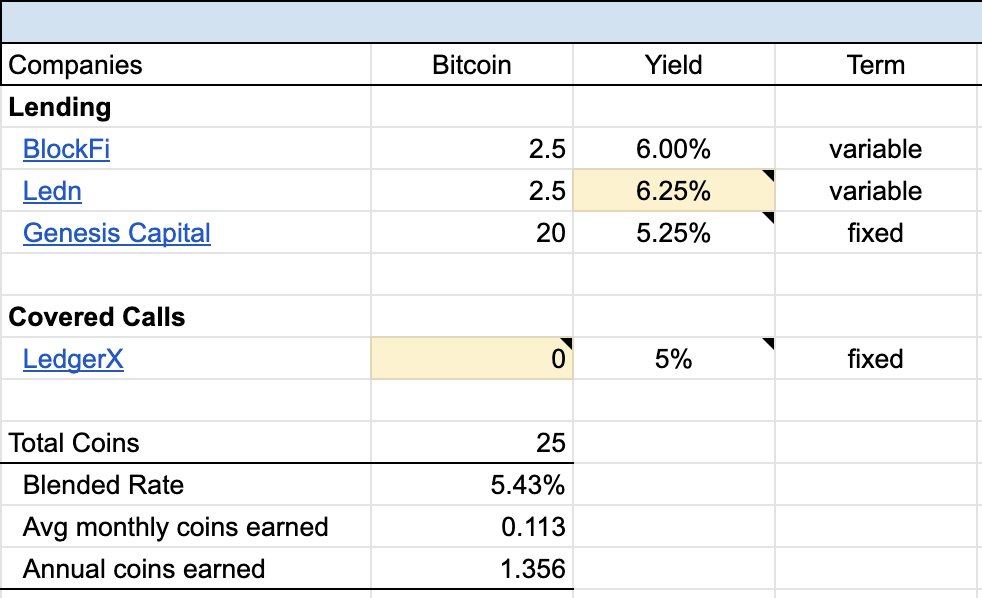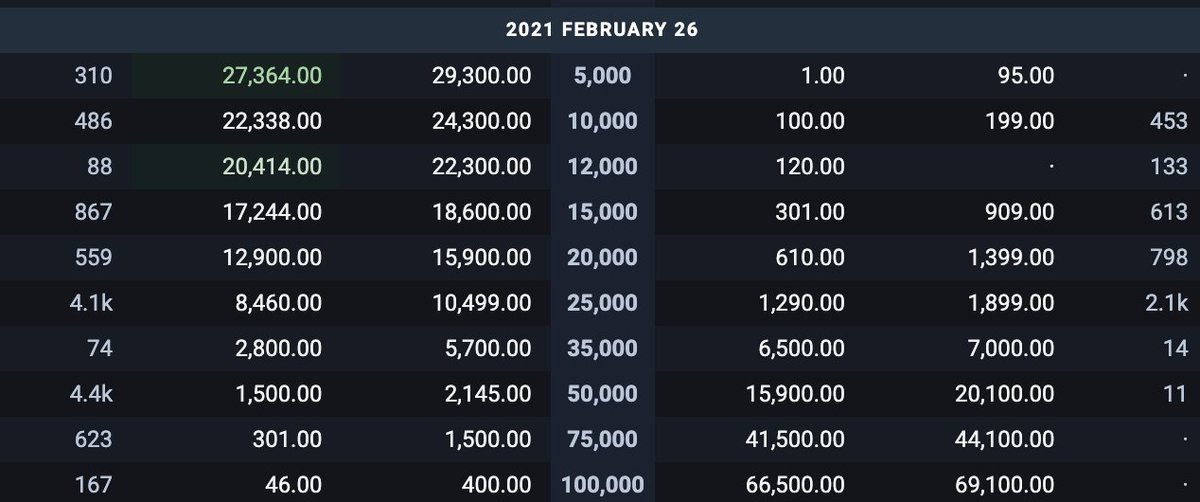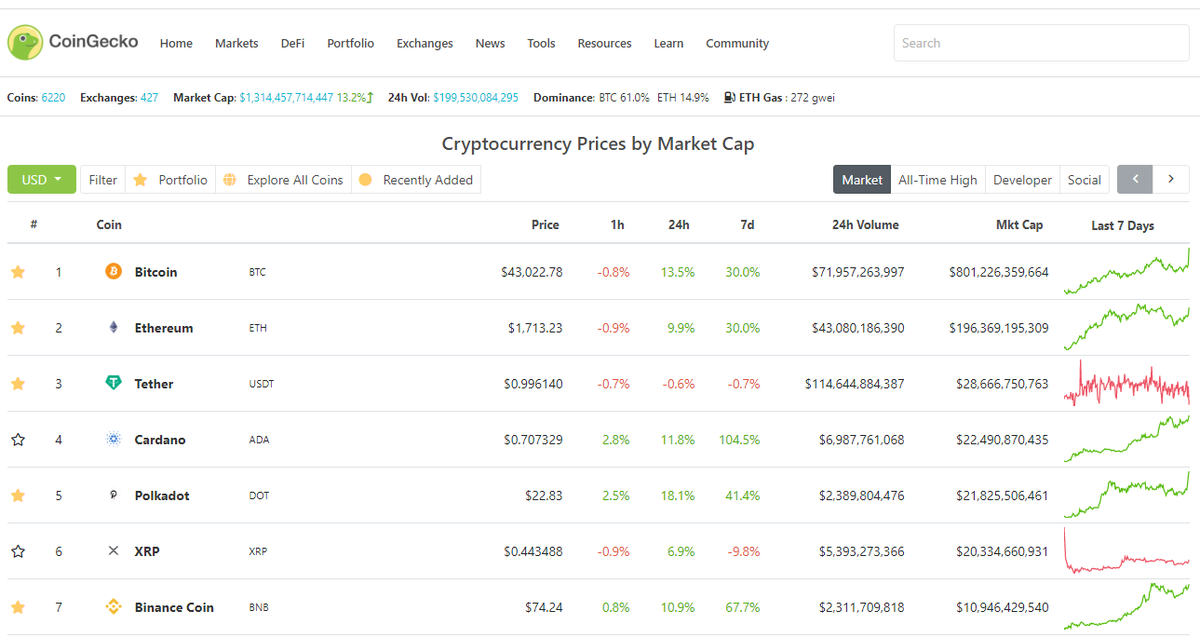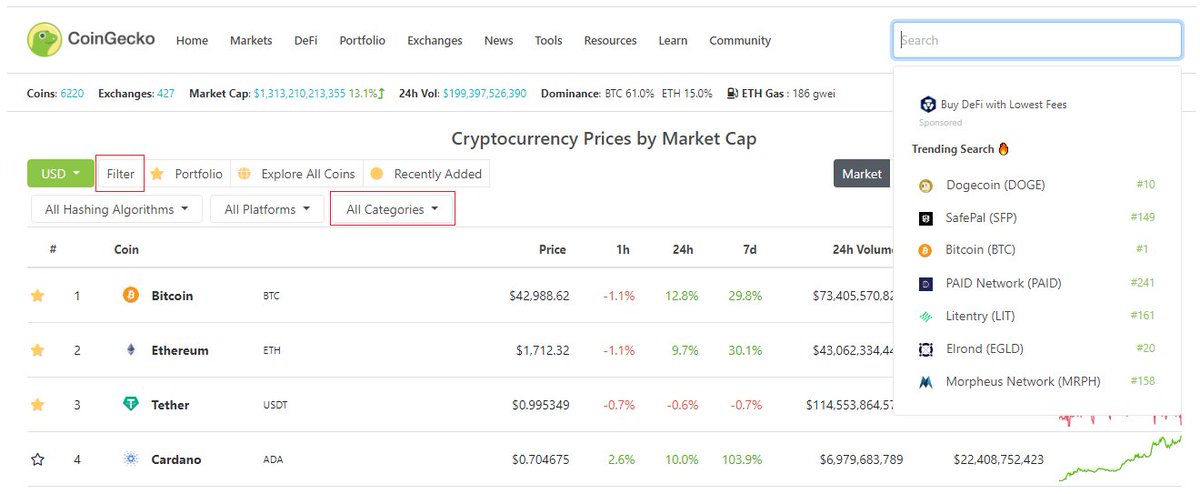2/ Here are the ways you can earn yield:
Lending (Easiest/most popular)
Yield: 3-6%
- Ledn:
https://t.co/4x0YATuQ0v - BlockFi:
https://t.co/90Xtg2cNka Covered calls (Harder)
Yield: 1-80%
- Deribit:
https://t.co/2iQVkXlylP - LedgerX:
https://t.co/hZ2pgMHYD1
3/ Earning a yield enables you to stack more sats (what I’m doing), or reduce the temptation to sell your coin through earning an income.
The yield you earn comes with RISK!
Below is my current allocation for Dec (will update MoM)
(yellow = changes)
https://t.co/PZwVYs8lFT
4a/ [Nov > Dec Changelog]
- Covered calls: approx. 4 BTC was in $40k 12/28/20 contracts. Those closed without them being exercised (a good outcome for me). However, I was nervous about my January 1/28 $50k contract so I decided to close out my position at a small loss.
4b/ [Nov > Dec Changelog]
- In process of reallocating the 5 BTC (probably will be a lending platform).
- I incorrectly had my Ledn rate at 6.5%, it's 6.25%
5/ When I first started, I had 10 BTC in BlockFi.
BlockFi is a lending/borrowing platform where you can lend your Bitcoin out for ~6% interest. Much of this borrow is going to the GBTC arb trade, shorting, or the futures “cash and carry trade.” (for all lending platforms)
6/ Risk assessment: When you lend your coins to Ledn, BlockFi, etc. you have to trust that they’ve evaluated counter party risk properly, which includes:
- Financials of borrower
- Collateral requirements (typically 30-110%)
- Trading strategy
7/ As everyone knows, March and December were insanely volatile months. Here’s how they operated through the volatility:
- Deposits and withdrawals all processed normally (1-2 business days)
- “zero losses in the lending book”
- All of the products had near 100% uptime
8/ Note: there may be no benefits to diversification as you do not know the counterparty overlap between lenders (ex: BlockFi and Genesis).
9/ Note: I am not a fan of lending/borrowing services that have a token. There is no reason why you need a token as it introduces regulatory and structural risk.
Case in point: Cred blew up earlier this year.
https://t.co/dBijOhgwIM
10/ There are other ways to earn interest through lending, which include lending coins to exchange margin pools:
- Bitfinex:
https://t.co/ydrPHVQEr6 What is beneficial about this method is you understand your counterparty risk.
11/ Lending is by far the easiest way for a regular trader to earn yield and at size if you’ve got more coin (ex: call strategies suffer from poor liquidity).
Next I’ll dig into covered calls👇
12/ What are “covered calls?”
It’s an option trade which has the owner of the underlying asset (“covered”) sell their upside above a certain price (“strike”) in exchange for a payment (“premium”)
The more likely that event occurring, the higher the premium (very simplified)
13/ So how does that look with some real numbers? (Pulled 1/5 split spread)
2/26 $50k strike = $1,822 premium (68% annualized)
2/26 $100k strike = $223 premium (8.3% annualized)
Annualized is a bit of misnomer -you don’t know what the yield will be the next time you sell calls
14/ Historically I’ve been selling $40k/$50k strikes 2-3 months out an earning an average of 4-6%
Because of how intense Bitcoin's bull run has been, I'm not selling any new calls for the time being.
15/ With covered calls you only have exchange custody risk, which is some of the lowest risk you can have.
One advantage of covered calls is that if you sell a 1yr+ duration call AND it gets assigned (price > strike) then your premium is taxed as long term cap gains (in the US)
16/ You can also earn a yield through trust minimized services like CoinJoins and providing lightning channel liquidity.
CoinJoins:
Yield: ~0.5%
Get started:
https://t.co/TQs5OvvB5s Lightning Pool
Yield: TBD
Get started:
17/ Coinjoins allow for Bitcoiners to obfuscate their coin holdings through mixing them with other Bitcoiners. In order to create a market of individuals willing to mix, there are makers and takers. Makers post availability to mix, takers pay the makers for that convenience.
18/ Lightning Pool
Most simplistically, it is an order book for lightning liquidity (or a channel marketplace) done in a non-custodial manner (note: there is a coordinating server).
18/ Hope you enjoyed this thread! I fell down the yield rabbit hole and haven’t looked back :)
If you haven’t already, check out my Google sheet where I’ve got all of this information available to you to play around with.
https://t.co/PZwVYs8lFT






